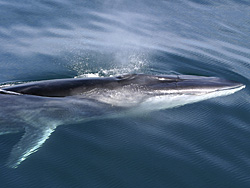Fin whale
Fin whale (Balaenoptera physalus), also known as the finback whale or razorback whale, is a marine mammal belonging to the suborder of baleen whales. It is the second-largest species on Earth after the blue whale. The fin whale's body is long and slender, coloured brownish-grey with a paler underside.
Description[edit | edit source]
The fin whale has a distinct ridge along its back behind the dorsal fin, which gives the species its common name. It can grow to lengths of up to 27 meters (88 ft) in males and 24 meters (79 ft) in females, with weights up to 74 tonnes. The fin whale's long body is supported by two pectoral fins, a dorsal fin, and a powerful tail fin used for propulsion.
Distribution and Habitat[edit | edit source]
Fin whales are found in all the world's major oceans, from polar to tropical waters. They are migratory, generally inhabiting colder waters in the summer to feed and warmer waters in the winter to breed. Their preferred habitats include deep offshore waters, but they can occasionally be seen closer to shore, in bays and estuaries.
Behavior[edit | edit source]
Fin whales are fast swimmers compared to other large whales, capable of reaching speeds of up to 23 miles per hour (37 km/h). They are known to be more solitary than other whales, although they can be found in small groups or pairs. Their diet consists mainly of small schooling fish, squid, and krill, which they filter through their baleen plates.
Conservation[edit | edit source]
The fin whale has been heavily hunted during the 20th century, leading to a significant decline in its population. It is currently listed as Vulnerable by the International Union for Conservation of Nature (IUCN). Various international laws and agreements now protect fin whales, but threats such as ship strikes, entanglement in fishing gear, and climate change continue to affect their population.
Research and Observation[edit | edit source]
Research on fin whales is ongoing, with scientists studying their population sizes, distribution, and behavior to better understand how to protect them. Observations are often conducted via boat or from shore, and sometimes through tagging and tracking individuals to study their migration patterns.
See Also[edit | edit source]
This marine mammal related article is a stub. You can help WikiMD by expanding it.
Search WikiMD
Ad.Tired of being Overweight? Try W8MD's NYC physician weight loss.
Semaglutide (Ozempic / Wegovy and Tirzepatide (Mounjaro / Zepbound) available. Call 718 946 5500.
Advertise on WikiMD
|
WikiMD's Wellness Encyclopedia |
| Let Food Be Thy Medicine Medicine Thy Food - Hippocrates |
Translate this page: - East Asian
中文,
日本,
한국어,
South Asian
हिन्दी,
தமிழ்,
తెలుగు,
Urdu,
ಕನ್ನಡ,
Southeast Asian
Indonesian,
Vietnamese,
Thai,
မြန်မာဘာသာ,
বাংলা
European
español,
Deutsch,
français,
Greek,
português do Brasil,
polski,
română,
русский,
Nederlands,
norsk,
svenska,
suomi,
Italian
Middle Eastern & African
عربى,
Turkish,
Persian,
Hebrew,
Afrikaans,
isiZulu,
Kiswahili,
Other
Bulgarian,
Hungarian,
Czech,
Swedish,
മലയാളം,
मराठी,
ਪੰਜਾਬੀ,
ગુજરાતી,
Portuguese,
Ukrainian
Medical Disclaimer: WikiMD is not a substitute for professional medical advice. The information on WikiMD is provided as an information resource only, may be incorrect, outdated or misleading, and is not to be used or relied on for any diagnostic or treatment purposes. Please consult your health care provider before making any healthcare decisions or for guidance about a specific medical condition. WikiMD expressly disclaims responsibility, and shall have no liability, for any damages, loss, injury, or liability whatsoever suffered as a result of your reliance on the information contained in this site. By visiting this site you agree to the foregoing terms and conditions, which may from time to time be changed or supplemented by WikiMD. If you do not agree to the foregoing terms and conditions, you should not enter or use this site. See full disclaimer.
Credits:Most images are courtesy of Wikimedia commons, and templates, categories Wikipedia, licensed under CC BY SA or similar.
Contributors: Prab R. Tumpati, MD





